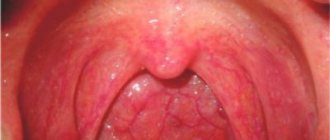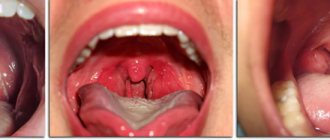28.06.2017
Head and neck diseases | Oropharynx and face
Hypertrophy is the growth of tissue. This reaction of the body serves as a response to increased stress on the organ. The most “physiological” example is muscle hypertrophy in weightlifters and bodybuilders. An enlarged liver often indicates intoxication of the body; proliferation of left ventricular tissue - the need to compensate for circulatory disorders caused by lung diseases, hypertension, etc.
Hypertrophy of the palatine tonsils (or tonsils) in most cases indicates that “attacks” on the main entrance gates of the body (mouth and nose) are so intense and frequent that the “personnel” of the “protective garrison” can no longer cope and asks for reinforcements.
The palatine tonsils are part of the immune organ - the lymphadenoid pharyngeal ring. They contain both the birth of new protective cells - lymphocytes (some of them perform their service “in place”, others enter the bloodstream and become available to the body), as well as the formation of very accurate and effective means of neutralizing the “enemy” - antibodies (especially in childhood). Elsewhere in the body, a similar role is played by the spleen, lymph nodes, and intestinal lymphoid tissue (including the appendix).
The palatine tonsils, it turns out, are also involved in digestion in the oral cavity: they contain enzymes that break down various food components.
Causes and course of the disease
Hypertrophic changes in the tonsils are considered as an immunoreactive condition that occurs when the body adapts to changing conditions and mobilizes compensation that has arisen in the lymphoid pharyngeal ring.
This is facilitated by breathing through the mouth, which is caused by hypertrophy of the adenoids, especially in the cold season. If adenoiditis provokes the formation of mucus, which forms in the nasal cavity, infects the palatine tonsils. Hyperplasia (increased cell proliferation) is promoted by infectious diseases and repeated inflammation in the oropharynx and nasal cavity.
Also, this process is influenced by poor living conditions, insufficient nutrition, as well as other factors that can reduce immunity. The size of the tonsils is affected by various disorders in the endocrine system, especially hypofunction (weakening of activity) of the adrenal cortex, exposure to small doses of radiation over a long period of time, hypovitaminosis (lack of vitamins).
The basis for too large an increase in the lymphoid tissue of the tonsils is the active proliferation (proliferation of tissue by cell multiplication) of immature T-lymphocytes and T-helper deficiency, which does not allow the production of full-fledged antibodies. The immunopathological predisposition of the child’s body to lymphatic diathesis, which is caused by hereditary deficiency of the lymphoid system, is influenced. Allergic reactions also influence the formation of hypertrophy of the palatine tonsils.
However, do not forget that hyperplasia is a reversible process. During adolescence, involution (reverse development) of lymphoid tissue occurs.
Hypertrophy of the palatine tonsils is often combined with a pathological enlargement of the entire pharyngeal lymphadenoid ring, especially often with hypertrophy of the pharyngeal tonsil (adenoids). Enlarged palatine tonsils generally have a dense and fairly elastic consistency, but in some cases they are spread out and soft on palpation. The palatine tonsils have no signs of inflammation and are not fused to the palatine arches. They have a developed lower pole and a triangular fold below, and the lacunae have a normal structure.
From a histological point of view, there is a predominance of hyperplasia of lymphoid tissue, in which there is an increase in the area of the follicles and the number of mitoses (indirect division), but plasma cells and macrophages are absent.
Hypertrophy of the palatine tonsils has 3 degrees:
- 1st degree - the palatine tonsils occupy 1/3 of the distance from the arch to the center of the pharynx (if measured along the midline of the pharynx);
- 2nd degree – already 2/3 of the distance mentioned above;
- 3rd degree – the tonsils are almost touching.
A microscopic examination reveals a large number of follicles with very frequent areas of mitosis, which indicates a very high activity of lymphoid tissue.
Friends! Timely and correct treatment will ensure you a speedy recovery!
What are the indications for adenoid removal (adenotomy)?
Adenotomy
- Cost: 50,000 - 80,000 rubles.
More details
- Poor nasal breathing during the period when the child is healthy. This is dangerous because the child’s body experiences hypoxia (oxygen starvation). Insufficient oxygen supply to the body can lead to a delay in the psychomotor development of the child; the child may be adynamic, or, conversely, hyperactive. Due to the fact that the child constantly breathes through his mouth, the facial skeleton (adenoid face) is formed incorrectly. The quality of life of such children certainly suffers.
- Hearing loss or frequent inflammation in the ears are also direct indications for adenotomy. The mechanism of occurrence of this pathology occurs as follows. Where the adenoids are located, there is the mouth of the auditory tube (Eustachian tube) - an organ that connects the middle ear (what is located behind the membrane) and the nasopharynx itself. If, with your mouth closed, you pinch the tip of your nose and exhale into your nose, then air will enter your ears due to this very organ. Due to the close anatomical location of the adenoids and the auditory tubes, the inflammatory process from the adenoids can move to the mouth of the auditory tubes, causing in turn inflammation and, as a consequence, dysfunction of the auditory tube. In addition to the chronic inflammatory process in the auditory tubes, when adenoids grow, they can cover the mouths of the auditory tubes, leading to the development of adhesive otitis media or the formation of exudative otitis media (fluid in the middle ear). Frequent purulent-inflammatory phenomena in the cavity of the middle ear (sound transmitting apparatus) lead to the formation of adhesions and scars between the auditory ossicles, which subsequently leads to hearing loss in adulthood. In these cases, between the organ of hearing and the natural filter in the form of adenoids, we choose the organ of hearing.
- It is also necessary to part with adenoids if the child often suffers from adenoiditis, which, with local treatment, does not produce significant positive dynamics, but only leads to recovery for a short period of time. This is a consequence of the fact that the adenoids do not carry out their immune function, they have worn out themselves as a natural filter, are a source of chronic infection and need to be sanitized (removed). Adenoiditis can also often be associated with herpes viral infection (Epstein-Barr virus, cytomegalovirus, type 6 virus), which live in the lymphoid tissue, leading to a decrease in immunity, including local immunity. If your child suffers from ARVI more than 6 times a year, there is cervical lymphadenitis (enlarged lymph nodes), conservative treatment of adenoiditis helps for a short time, in this case you need to contact a pediatrician for further examination for a herpes viral infection. When this group of viruses is detected, adequate treatment is prescribed, and if positive dynamics are observed in the adenoids during therapy, the child should be observed and there is no need to rush into surgery.
But if, together with treatment from a pediatrician, no effect is observed, then, according to the law of surgery, the tissue that prevents a person from living is removed.
Clinical picture
Hypertrophied palatine tonsils have a pale pink color, a smooth surface, clearly defined lacunae and a loose consistency.
They protrude somewhat beyond the edges of the anterior palatine arches. Patients complain of coughing, difficulty swallowing and breathing. There may be a speech disorder that occurs due to changes in the upper resonator, as a result of which the voice becomes nasal. Make an appointment right now!
Call us by phone or use the feedback form
Sign up
Due to brain hypoxia (oxygen starvation), patients sleep very restlessly at night, insomnia and night cough are possible. As a result of relaxation of the pharyngeal muscles, attacks of obstructive apnea (temporary cessation of breathing during sleep) may occur. Due to tubular dysfunction (the initial stage of dysfunction of the system), hearing impairment occurs, and the formation of exudative otitis media (ear inflammation) is possible.
Diagnostics
Diagnosis of hypertrophied tonsils is not difficult. The data from pharyngoscopy are used as a basis. The pathology has several degrees of severity, taking into account the stage of development. The extreme stage involves the contact of the tonsils with each other.
Despite the absence of inflammation, it is necessary to differentiate hypertrophy from chronic tonsillitis and tumors. The latter are represented by lymphosarcoma and lymphogranulomatosis, the characteristic features of which are asymmetry, increased tissue density and metastases.
According to indications, blood tests and biopsies are also prescribed, the results of which help clarify the diagnosis. The fluctuation method used during palpation helps to distinguish hypertrophy from an abscess or cyst. It is usually combined with a diagnostic puncture, which involves suctioning out the contents.
Treatment
If there are complaints of difficulty swallowing and breathing, cough, or speech disorders, it is recommended to partially remove the tonsils (tonsillotomy) when the child reaches 5-7 years of age.
But such an operation has the following contraindications: acute infectious diseases, blood diseases, diphtheria bacilli carriage. Tonsillotomy is not recommended for polio outbreaks. ENT surgery can be performed on an outpatient or inpatient basis, both under anesthesia and local anesthesia. It is not uncommon to perform a bilateral tonsillectomy - complete removal of the tonsils.
Hypertrophy of the palatine tonsils in children
Often patients are children aged 5 to 7 years with a complicated history of adenoiditis. In such cases, both tonsillectomy and adenoid removal are performed as part of one intervention. The postoperative stage requires you to follow a diet. Food should be non-irritating, gentle, without adding seasonings. The drink is warm.
You can call an ENT doctor at home or make an appointment with a doctor through the form on the website or by calling the clinic. The doctor will examine the throat and, if hypertrophy is diagnosed, prescribe treatment.
The operation can also be performed on an outpatient basis. In this case, it is necessary to ensure constant monitoring of the patient, which is carried out until the final healing of the wound.
Adenoid hypertrophy: treatment
At the first stage of treatment, the doctor determines the tactics - to be treated on an outpatient basis or to prepare for surgical removal. If adenoids interfere with breathing, prevent sleep, cause breathing apnea during sleep, or cause complications - hearing loss, damage to the cardiovascular system, kidneys - consider the possibility of surgery. If there is evidence, you shouldn’t be afraid of her. In case of exacerbation of chronic diseases, in the acute period of infections, blood clotting disorders, severe heart diseases, surgery is contraindicated. We are ready to organize treatment, including surgery, in clinics in St. Petersburg or partner clinics abroad, in Finland, Switzerland, Austria, and accompany patients from the first visit to recovery. Even grade 1 adenoid hypertrophy must be treated. At the second stage of treatment, if conservative methods are indicated, the doctor prescribes drugs - antiviral, antibacterial, antiallergic. Plus, local procedures are carried out to cleanse the nasal cavity of mucus and physiotherapy. It is important to restore the immune function of the adenoids. This is carried out by qualified doctors. You should not interfere with the functioning of the immune system yourself. At the third stage of treatment, the doctor evaluates the effect and adjusts the therapy. Follow the rules:
- avoid provoking factors - cold drinks, dust, air polluted by industrial emissions and tobacco smoke,
- humidify the air and ventilate more often,
- take a walk in the fresh air
- Avoid contact with people with colds.
At the fourth stage of treatment, the doctor determines the frequency of follow-up examinations and studies in order to monitor the condition and notice a relapse in time.
What result should I expect?
- Nasal breathing is normalized,
- Nasal discharge stops,
- Snoring disappears
- The frequency of viral infections is reduced,
- The general condition improves - vigor and energy appear, memory and attention improve.
Prevention of adenoid hypertrophy in children and adults
- Reduce the infectious load,
- Treat ARVI - you should not take a child who has not fully recovered to school or kindergarten,
- Moisturize the nasal cavity with saline solutions,
- Humidify the air in the apartment,
- Ventilate more often
- Give your child enough to drink
- Avoid contact with aggressive substances, including tobacco smoke,
- Strengthen your immune system: less stress and TV and computer, more fresh air and physical activity. Plus proper nutrition.
All these activities improve local immunity, which means they reduce the likelihood of “catching” a virus or bacteria. And then you won’t have to search for “adenoid hypertrophy symptoms and treatment” in a search engine.
Causes and symptoms of chronic tonsillitis
If general immunity is reduced and/or the body has had to face a powerful infectious attack (for example, a sore throat or infection with herpes viruses), a real battle between the immune system and microbes unfolds in the lacunae of the tonsils. As a result, pus, consisting of dead microbes and cells (purulent-caseous plugs), accumulates in the lacunae. Tonsils clogged with pus stop working as an immune organ , and pathogenic microbes thrive in the purulent contents of the lacunae and multiply. These are the so-called plugs in the tonsils. At this stage of the process, it is enough to wash the tonsils from pus and provide a little help to the immune system, after which the normal function of the tonsils is restored.
Chronic tonsillitis, tonsil in section. 1 – lacunae of the tonsil. 2 – the entrance to the lacuna is blocked by a purulent plug. 3 – entrance to a clean lacuna. On the right - vacuum rinsing of the tonsils - a painless and quick procedure. 8-10 seconds - and the plugs are washed with a disinfecting solution.
Symptoms of chronic tonsillitis:
- Painful sensations in the throat area
- Enlarged lymph nodes
- Bad breath
- Sometimes there are headaches
- Sometimes there is discomfort in the ears
- The waste products of microbes from the tonsils enter the bloodstream , poisoning the body (tonsillogenic intoxication); hence fatigue, pain in muscles and joints, headaches, decreased mood, and even, in some cases, a prolonged increase in body temperature;
- Tonsils become a reservoir of infection , from where it can spread throughout the body and cause inflammatory processes (acne, cystitis, prostatitis, adnexitis, dysbacteriosis, inflammation of the paranasal sinuses, etc.);
- Bad breath - it is caused by organic substances decomposing in the gaps; 4. The tonsils stop working as an immune organ , immunity decreases, and the slightest provocation (hypothermia, overwork, stress) can “finish off” the immune system and open the way for germs.
Causes of hypertrophy of adenoids and tonsils: why is this happening to your child?
Excessive load of infection.
Bacteria and viruses, and often a combination of both.
The body cannot cope with the load, the lymphoid tissue increases, but does not completely fulfill its function. Heredity.
If you suffered from the same disease as a child, unfortunately, your child is at a higher risk of developing adenoid hypertrophy.
The special structure of the lymphatic system - the so-called lymphatic-hyperplastic diathesis - is a predisposing factor to hypertrophy of the adenoids and tonsils. Unfavorable microclimate conditions.
Dry air, especially during the heating season, warm air, lack of fluid, “accumulators” of dust and other allergens do not contribute to free breathing through the nose.
And this is a direct path to frequent colds and adenoids. Lymphotropic viruses.
In particular, the infectious mononucleosis virus (Epstein-Barr), cytomegalovirus, in which lymphoid tissue, liver and spleen enlarge.










